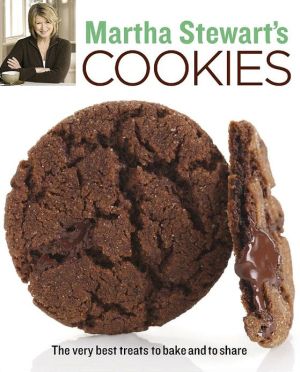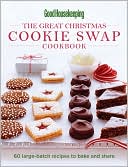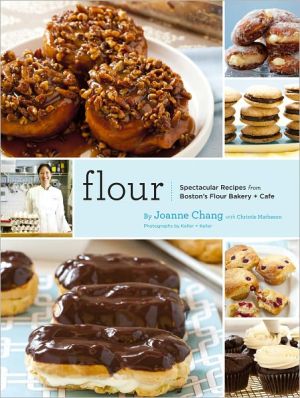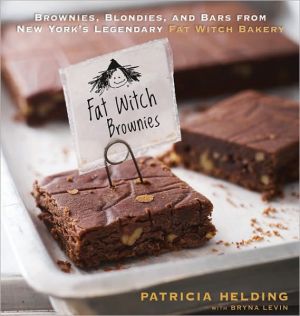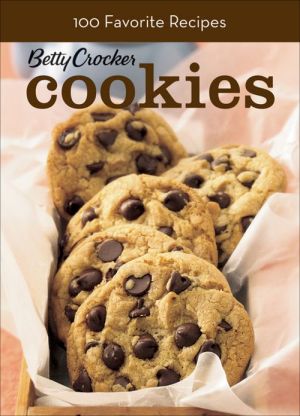The Gourmet Cookie Book: The Single Best Recipe from Each Year 1941-2009
For this stunning collection, the editors of Gourmet delved deep into their archives and selected the most delicious cookie for each year of the magazine’s sixty-eight-year existence. After marathon testing sessions and winnowing from thousands of recipes—many sent in by readers—they chose an amazing array, from the almond-scented French-style Cajun Macaroons, from the magazine’s beginnings in 1941, through Mocha Toffee Bars (1971), to the contemporary Glittering Lemon Sandwich Cookies. The...
Search in google:
For this stunning collection, the editors of Gourmet delved deep into their archives and selected the most delicious cookie for each year of the magazine’s sixty-eight-year existence. After marathon testing sessions and winnowing from thousands of recipes—many sent in by readers—they chose an amazing array, from the almond-scented French-style Cajun Macaroons, from the magazine’s beginnings in 1941, through Mocha Toffee Bars (1971), to the contemporary Glittering Lemon Sandwich Cookies. The enticing assortment includes Cookies of every type and description, from the homey (Aunt Sis’s Strawberry Tart Cookies) to the exotic (Grand Marnier-Glazed Pain d’Epice Cookies), including balls, bars, refrigerator cookies, drop cookies, even deep-fried cookie confections. Cookies from around the world: from Dutch Jan Hagels to Irish oatmeal sandwich cookies filled with cream and Irish whiskey, to Scandinavian Rosettes. Dozens of Christmas cookies: Old-Fashioned Christmas Butter Cookies, star-shaped Moravian White Cookies, Chocolate Peppermint Bar Cookies. Printed exactly as they originally appeared in the magazine, with abundant tips and recipe notes from Gourmet’s test kitchen, and with headnotes describing their cultural context, the recipes present a fascinating bite-by-bite history of how our appetites evolved. The New York Times - Christine Muhlke …features one recipe for every year Gourmet magazine was in business, making for 69 gems in this beautifully designed keepsake.
INTRODUCTION Buy a cookie, and it's just a bite of sugar, something sweet to get you through the day.\ Bake a cookie, on the other hand, and you send an instant message from the moment you measure out the flour. Long before they're done, the cookies become a promise, their endlessly soothing scent offering both reassurance and solace. And even the tiniest bite is powerful, bringing with it the flavor of home. For anyone who is comfortable in a kitchen, a warm cookie is the easiest way to say I love you.\ Somewhere in the back of our minds, we all know this. It is the reason we bake cookies at Christmas, why we exchange them as gifts. Not for nothing do we pack up our cookies and send them off to our far-flung families. Like little ambassadors of good will,\ these morsels stand in for us. There are few people who don't understand, at least subconsciously, how much a cookie can mean.\ But until we began work on this book, it had never occurred to us to look at history through a cookie prism. When we decided to select the best cookie from each of Gourmet's sixty-eight years, we knew we would end up with an awesome array of treats.\ But we did not realize that we would also discover a way of charting the changes in the way that we eat. Our cookie cravings, it turns out, offer a fascinating window on history,\ a portrait of our country that reveals the way our appetites have evolved.\ We were so captivated by the language of cookies that we have printed the recipes exactly as they originally appeared. In the early years, they are remarkably casual, a kind of mysterious shorthand that assumes that each reader is an accomplished cook who needs very little in the way of guidance. "Bake in a moderate oven until crisp," is a classic instruction. So is "Add flour until the dough is stiff." It's interesting to watch as numbers creep into the recipes in the form of degrees, minutes, and cups. And it's startling to observe the recipes growing longer and longer as they become increasingly precise.\ Although we have left the language of the recipes unchanged, we have removed the guesswork; when we retested, we added notes, so that you'll know exactly how hot your oven should be, and how many cups of flour it takes to stiffen that dough.\ Cookies turn out to be an excellent indicator of what we have been eating. The instinct to bake them is essentially conservative, which means that cookies are rarely the first place that new ingredients appear. An ingredient must have a solid place at America's table before it makes its way into the cookie cupboard. So when pistachios start showing up in cookies in the eighties, you know that the luxurious nut has finally become part of the American food landscape. And when, in the early nineties, espresso stops making the occasional appearance and turns into a standard ingredient, it is no accident; this is just when venti became part of our vocabulary, a sign that America's drinking habits had undergone a serious revolution.\ Looking at cookies in this way is a fascinating exercise. It is also a great predictor of future trends. Work your way through this book and you'll be in a very good position to know what cookies we'll be baking next year, and the year after that. But while new cookies keep being invented, old cookies never die. They just get better and better. We like to think that you'll be baking the ones in this book for many years to come.\ —The Editors\ 1941 - Cajun Macaroons America's first epicurean magazine had very ambitious plans. Although war was imminent,\ you wouldn't have known it from turning the pages. In this, the second issue, Gourmet's chef, Louis P. DeGouy ("de goo-ey"), taught his readers how to cook a duck. They could also read about "Famous Chefs of Today";\ peruse the first installment of "Clementine in the Kitchen," the story of a French cook\ (the series eventually became a beloved book); and shop vicariously at a store that specialized in dates (it sold Deglet Noors,\ Golden Saidys, and black Hyanas). Turning to the menus, they found a rather elaborate celebration of Mardi Gras in New Orleans,\ complete with oysters rockefeller, Creole soup, papaya balls, pompano fillets, pigeon pie, poinsettia salad (canned pineapple,\ pimiento strips, cream cheese moistened with French dressing, and paprika), creamed peas, and sugared yams.\ But the best thing about the menu was the finale: crisp, chewy little cookies with a subtle almond scent. Although the recipe required a lot of work, readers would beg for it again and again over the years.\ Happily, the food processor has taken most of the labor out of these French-style macaroons, and today they are a breeze to make.\ Makes about 4 dozen 1 1/2-inch cookies\ These should be baked a few days in advance. They will keep several months when kept in a closed tin in a cool, dry place.\ Work 1/2 pound almond paste with a wooden spoon until it is smooth.\ Add 3 slightly beaten egg whites and blend thoroughly. Add 1/2 cup sifted pastry flour, resifted with 1/2 cup fine granulated sugar and\ 1/2 cup powdered sugar. Cover a cooky sheet or sheets with bond paper.\ The cooky mixture may be dropped from the tip of a teaspoon and shaped on the paper, or may be pressed through a cooky press, or shaped with a pastry bag and tube. Bake in a slow oven (300° F) about\ 30 minutes. The cakes may be removed from the paper by means of a spatula while still warm.\ Variations: Finely chopped or ground candied fruits may be added to the mixture before baking. Or the tops of the macaroons may be decorated before baking by placing in the center of each a nut half, a raisin (seedless, black or white), or a bit of candied fruit—such as a bit of angelica—cut fancifully, or by sprinkling with finely chopped nut meats. The cakes may be decorated after baking by dainty frosting designs formed with the help of a cake decorator or a pastry tube.\ Recipe Notes\ 1. The almond paste should be at room temperature.\ 2. Rather than working the almond paste with a wooden spoon, use a food processor.\ 3. Use White Lily flour (see Sources, page 154) or cake flour (not self-rising) in place of the pastry flour.\ 4. Use regular granulated sugar in place of fine granulated sugar.\ 5. In place of the bond paper that the recipe calls for, use parchment paper.\ 6. The cookies should be pale golden.\ 1971 - Speculaas\ (Saint Nicholas Cookies)\ A former minister of foreign affairs in Holland offended many cooks when he informed the world that the speculaas was Europe's best cookie. That is a matter of opinion, but it is a matter of fact that they are among the oldest cookies on record, for speculaas have been baked in the Netherlands for centuries. They began life as gifts to the gods, left in the fields as offerings to ensure a good harvest. But humans are equally enamored of this cross between a spice cookie and a shortbread because of their comfortingly robust and old-fashioned flavor.\ Makes about 4 dozen cookies Into a bowl, sift together 3 cups flour, 4 teaspoons baking powder, 1 tablespoon cinnamon, 1 teaspoon each of cloves and nutmeg, and 1/2 teaspoon each of ground aniseed, salt, and ginger or white pepper. In a bowl of an electric mixer, beat 2 sticks, or\ 1 cup, butter, softened, with 1 1/2 cups firmly packed dark brown sugar until the mixture is light and fluffy. Stir in 3 tablespoons milk, dark rum, or brandy.\ Gradually add the flour mixture, stirring until it is well combined, and form the dough into a ball. Knead the dough on a board sprinkled with about 1/4 cup flour and roll it out into a rectangle 1/4 inch thick. With a sharp knife or cutter, cut the dough into rectangles\ 2 1/2 inches by 1 1/2 inches. Put the rectangles on a buttered cookie sheet, decorate them with blanched almonds, halved or slivered, and brush them with lightly beaten egg white.\ Bake the cookies in a moderately hot oven (375°F) for 12 to 15 minutes, or until they are browned and firm.\ Recipe Note Gently push the nuts into the dough before brushing the cookies with egg white
\ From Barnes & NobleTo commemorate their extraordinary sixty-eight year run (and perhaps to satisfy their taste buds), the editors of Gourmet searched their archives for the most delicious recipes of the tens of thousands sent in by readers. From this towering sugary mound, Gourmet selected the sixty-eight best, one for each year of the magazine's history. The kitchen-tested winners of this flavor hunt include Chocolate Peppermint Bar Cookies, Aunt Sis's Strawberry Tart Cookies, Dutch Jan Hagels, Scandinavian Rosettes, and Moravian White Cookies. And if you're really ambitious, you can make all sixty-eight finalists and choose a grand prize winner!\ \ \ \ \ \ From the Publisher"It represents a snapshot of American cookery...an incredible seven decades’ worth of cookies complete with mouthwatering photographs."\ ——Library Journal, starred\ \ \ \ Library JournalGourmet magazine, from its first issue in 1941 until its last in 2009, reflected changes in American tastes, such as the reign of coconut (1960s), pistachios (1980s), and espresso (1990s). The introduction includes tips for ingredients, measuring, equipment, and techniques. The concise recipe instructions are written for the experienced baker. This amazing collection features such cookies as Brandy Snaps, Fig Cookies, Mocha Cookies, Scandinavian Rosettes, and Mini Black and White Cookies. It represents a snapshot of American cookery—an incredible seven decades' worth of cookies complete with mouthwatering photographs. [Three-city tour with former Gourmet executive chef Sara Moulton.]\ \ \ \ \ Christine Muhlke…features one recipe for every year Gourmet magazine was in business, making for 69 gems in this beautifully designed keepsake.\ —The New York Times\ \

